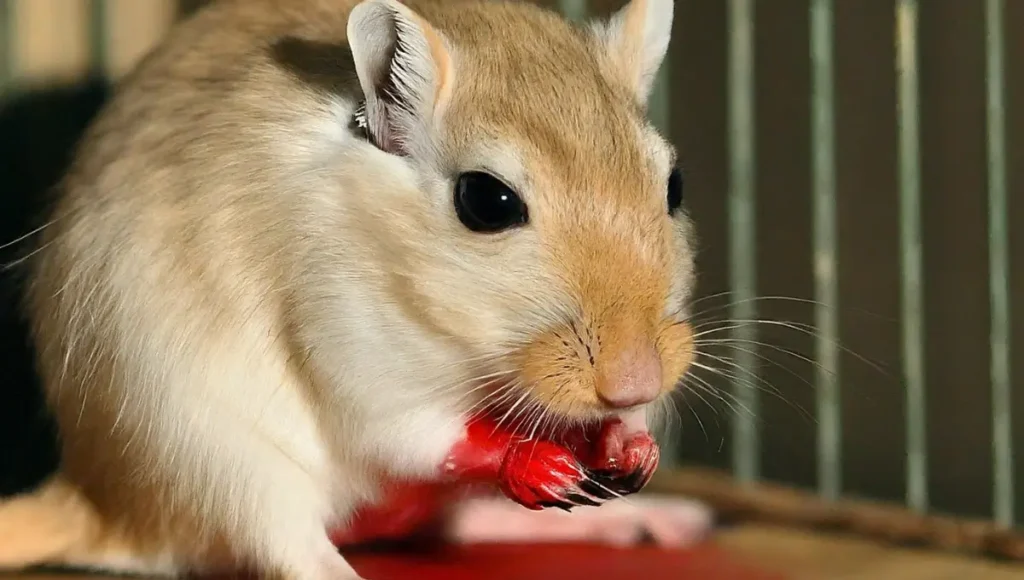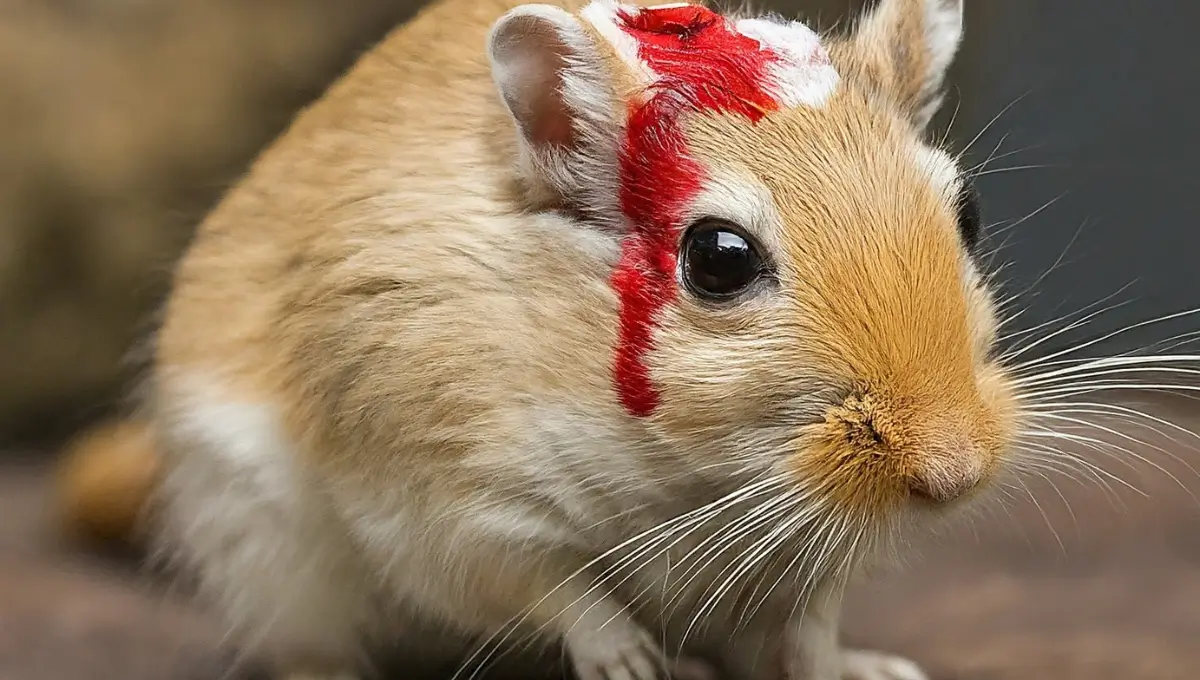Gerbils are charming, curious creatures that make delightful pets for people of all ages. Their playful nature and minimal care requirements have endeared them to many. However, like all pets, gerbils can encounter health issues, including injuries that may lead to bleeding.
Understanding how to promptly and effectively respond to these situations is crucial for any gerbil owner. In this article we will guide you what steps to do if you see your gerbil is bleeding and how to prevent injuries in gerbils in the future.
Recognizing the Signs of Bleeding in Gerbils
The first step in addressing any health issue is correctly identifying the problem. Bleeding in gerbils can sometimes be subtle, so vigilance is key. Blood may not always be immediately visible, especially if the gerbil has a dark coat or if the bleeding is internal.
Look out for signs of distress, such as lethargy, unusual aggression, or a lack of appetite, which can indicate pain or discomfort. Physical signs include visible blood on their bedding, fur, or in their enclosure. The source of bleeding can vary, ranging from the nose, tail, limbs, or even internal bleeding evidenced by blood in their urine or stools.
What to Do if your Gerbil is Bleeding?
When you notice your gerbil is bleeding, the first step is to calmly assess the situation to determine the severity of the injury. Here are immediate actions you should take:
- Separate the Injured Gerbil: If you have multiple gerbils, separate the injured one to prevent further stress or injury from its cage mates. This isolation also allows you to monitor the injured gerbil more closely.
- Applying First Aid: If the bleeding is external and accessible, gently clean the wound with saline solution or clean water. Avoid using cotton, as it can stick to the wound. Instead, use a soft, lint-free cloth. Apply gentle pressure to the wound with a clean, soft cloth to help stop the bleeding. Avoid using any over-the-counter ointments or creams unless directed by a veterinarian, as some can be toxic to gerbils.
- When to Seek Veterinary Care: If the bleeding does not stop, if the wound is deep, or if you suspect internal injuries, it’s crucial to seek veterinary care immediately. Even if the bleeding stops, a vet visit is advisable to assess for underlying issues and prevent infection. Remember, not all vets specialize in small animals, so it’s beneficial to find a vet experienced with gerbils or small rodents.
Understanding and Treating Common Causes of Bleeding in Gerbils

Gerbils, with their curious and energetic nature, can sometimes find themselves in situations leading to injuries and bleeding. As a responsible pet owner, recognizing the common causes and knowing how to address them is crucial for the well-being of your furry friend.
Let’s delve into some typical scenarios that might cause your gerbil to bleed and how to handle them.
1. Fighting and Wounds
Gerbils are social animals that usually enjoy the company of their kind. However, disputes over territory or hierarchy can lead to fights, resulting in injuries. Declanning, a term used when a gerbil group’s social structure collapses, often results in the most severe fights.
To prevent these situations, monitor your gerbils’ interactions closely, especially when introducing new members to an established group. If you notice persistent aggression, separate the gerbils to avoid injuries.
For wounds, gently clean the area with saline solution and consult a vet for further care, including potential antibiotics to prevent infection.
2. Scent Gland Issues
The scent gland, located on the belly of a gerbil, is used for marking territory but can become problematic, leading to bleeding if infected or overused. If you notice your gerbil excessively grooming this area or find it inflamed, a vet visit is necessary.
Treatment might include antibiotics or, in rare cases, surgical intervention to remove any tumors or severe infections.
3. Tail Injuries
Tail injuries, including the dreaded tail slip where the skin detaches from the tail bone, are particularly distressing. These injuries can occur if the tail is caught or pulled. It’s vital to handle your gerbil gently, supporting its entire body to prevent such accidents.
If a tail injury occurs, it’s essential to keep the wound clean and seek veterinary advice, as the exposed bone can lead to further complications.
Also read: Do Gerbils Have Periods?
Post-Treatment Care for Your Gerbil
After addressing the immediate concern of bleeding, providing proper care to ensure a full recovery is essential. Here are some tips to help your gerbil heal:
- Create a Comfortable Environment: After any injury, a stress-free environment is crucial for recovery. Keep the gerbil’s habitat warm, quiet, and clean. Consider using softer bedding, like paper-based products, to prevent irritation to the wound.
- Monitor for Infection: Keep a close eye on the injury for signs of infection, such as increased redness, swelling, or discharge. If you observe any of these signs, please contact your veterinarian immediately.
- Adjust Diet and Hydration: Ensure your gerbil has easy access to food and water. You might need to provide softer foods if the injury affects their ability to eat normal food.
Preventing Future Incidents
Prevention is always better than cure, especially when it comes to pet injuries. Here are some strategies to minimize the risk of bleeding in gerbils:
- Proper Housing: Ensure your gerbil’s enclosure is safe, with no sharp edges or small gaps they could get stuck in. Regularly inspect the habitat for potential hazards and remove or repair any that you find.
- Companionship and Socialization: Properly introduce new gerbils to each other to reduce the risk of aggressive behavior. Providing ample space and resources, like food bowls and water bottles, can also minimize competition and fighting.
- Regular Health Checks: Regularly checking your gerbil for any signs of injury or illness can help catch issues before they become serious. Pay particular attention to their activity levels, appetite, and grooming habits, as changes can indicate health problems.
By understanding the common causes of bleeding in gerbils and how to address them, you can ensure your pet remains healthy and happy.
FAQs
What should I do if the bleeding doesn’t stop?
If you’ve applied first aid and the bleeding continues for more than a few minutes, or if it stops but starts again, it’s crucial to seek veterinary care immediately.
Continuous bleeding could indicate a more serious injury or condition that requires professional treatment. Remember, the quicker you act, the better the chances of a full recovery for your gerbil.
How can I tell if my gerbil is in pain?
Gerbils, like many small animals, are adept at hiding pain due to their instincts. However, there are signs you can look for, including changes in behavior such as increased aggression or withdrawal, loss of appetite, unusual vocalizations, or a decrease in normal activities.
If your gerbil is injured and you suspect it’s in pain, consult with a vet for appropriate pain management strategies.
Can gerbils recover from serious injuries?
Yes, with prompt and proper care, gerbils can recover from serious injuries. Their resilience and the ability to heal with the right support from their owners and veterinary care are remarkable.
Post-injury care, including a clean, safe environment and monitoring for signs of infection or distress, plays a crucial role in their recovery process.
How often should I check on my gerbil after an injury?
In the immediate aftermath of an injury, it’s advisable to check on your gerbil every few hours to assess their condition and comfort level.
Once stable, a daily check-up is essential to monitor the healing process, ensure the injury site is clean, and observe for any signs of infection or behavioral changes. Always follow your vet’s advice on care and monitoring post-injury.
Conclusion
Caring for a gerbil requires a blend of love, attention, and knowledge. Understanding how to respond when your gerbil is bleeding, recognizing signs of pain, and knowing the potential for recovery are all crucial aspects of pet ownership.
Remember, prevention is key. Regularly inspect your gerbil’s living environment for safety, provide a balanced diet, and ensure they have plenty of opportunities for exercise and social interaction to keep them healthy and happy.











